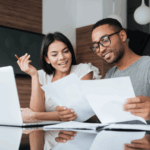Number 10: “Connect that passé.”
While rehearsing for competition, make sure you’re taking time to discuss the proper technique of a passé; whether being utilized in a pirouetté, fouetté, piqué or retiré. As a teacher I teach that the passé should be connected at the highest point of the supporting leg at which the hips can remain square. For most dancers this will be at or slightly above the knee. As you train, make sure you physically FEEL the connection between your supporting leg and the foot/toes of your passé. Otherwise – you just have a bent leg hanging out in space! And while we are at it – always define whether that passé is parallel or turned out!Number 9: “Shoulders down and back.”
If this were my personal critique list, I think this might hit #1… Those of you who have had critiques from me most likely hear an earful about shoulders! There is a technical as well as aesthetic appeal to having a nice long neck and open chest. Plus you look more confident, aware, awake, and presentable! So, use those lats and anchor the shoulders down in all of your routines!
Number 8: “What is your story/emotion/expression?”
There are few things we love more than a routine that leaves us laughing, crying, thinking… just FEELING something! Discuss with your team how to express your emotion through each piece. In a solo, find a deeper reason or motivation behind your movement and use your face – your eyebrows can do wonders – to express this deeper meaning. In group pieces, make it a part of rehearsal to decide upon a feel, story, theme, or idea – then make sure each dancer is committed to it 100%!
Number 7: “Iron out your transitions.”
In choreography there are often many boxes that we check in order to create a competition routine. Pirouettes? Check. Floor work? Check. Battement? Check. Leaps? Check. But what really takes the choreography and execution of a routine to the next level is going into and out of those elements seamlessly and with creative smooth transitions. Use the delay of your head or port de bras to tie one moment to the next. Use your feet through the floor to smooth out landings and think “lift up” as you go down into your floor work to keep it light and smooth. When our transitions get sloppy the dance can quickly become a segmented list of individual “tricks”.
Number 6: “SPOT.”
I hear this one word at the judging table A. LOT. Really work on this in your technique classes. It is a hard element to master – but it can save your pirouettes! Keep your spot lifted; don’t spot the floor. Try to keep your neck from stiffening up. In rehearsal, turn off the lights to emulate the feeling of spotting a dark auditorium. It can be tricky to spot looking into the dark!
Number 5: “Listen to your music.”
Musicality is an essential component to a successful routine. When we get on stage and our adrenaline starts to rush, we tend to do the same… rush! Breathe deep. Enjoy your time – every beat – every count. Don’t turn off your thoughts and go into muscle memory. Hear the music. Let it enter your ears, sink into your bones and come out through your movement. Also, as you rehearse make sure you are clarifying the timing and musicality regularly. You want your dance to be the physical representation of what is coming out of the speakers!
Number 4: “Rehearse more/clean it up.”
I’ve worked at studios, so I know how frustrating this critique can be. We do what we can in the time we have, right? Regarding your performance routines, may we suggest quality over quantity? You want to put your best foot forward (pardon the pun) and when we go overboard on routines, often times none of them end up looking fully polished. I have often felt like a dance that had so much potential didn’t quite make it – simply because it didn’t looked well rehearsed. Give yourself the time to make each piece look its best.
Number 3: “Where are your eyes?”
I do not believe that a dancer should have to stare down the judges from start to finish… after all, there is an entire audience behind us! However, there needs to be LIFE in your eyes. Do not look down unless specifically choreographed. Looking down pulls your energy down, it makes you look nervous and insecure. Pulling your gaze up and putting some feeling behind your eyes shows confidence and a connection with your audience. A trick I have given many dancers is to look right between the judges, or right over their heads. That way you won’t have to look them right in the eye and get nervous, but it will still give us the impression that you are making eye contact. Once again, it doesn’t need to be a stare down – just a measure of life, emotion, confidence and FOCUS coming through your eyes, no matter where they are looking!
Number 2: “Don’t take on technical “tricks” for which you aren’t ready.”
This is a big one. We understand that you are excited to get on stage and show the audience what you have been working on. And while we applaud teachers for challenging and stretching their students in class, as a judging panel we have all agreed that – when it comes to performances – it is best to stick to what you can accomplish correctly. We would much rather see a well executed single pirouette than a triple that is flat footed with a detached passé lacking a defined spot. Remember to be patient in your training. There will be a time and place for amazing turns and leaps; but for now, work hard on your technical elements in class, then put them in your routine when you are consistently hitting them. You need to first establish a solid foundation of basics if you want to build a great castle of talent!
Number 1: “Stretch your legs and feet.”
Yeah, yeah, we’ve heard it a thousand times, right? Yet, still, as a panel it is most definitely and without competition the most commonly used phrase that passes our collective lips! The stretch through our legs and feet is something even professional dancers continue to work on. It should be discussed through every rehearsal – not just technique class. Really pay attention to your supporting side. There needs to be just as much energy in the supporting side as there is in the working side. I always say “battement with BOTH legs!” meaning – give just as much strength and energy down to the floor as you do up through your kick. Watch that pesky floor work. That is when we really notice sickled, crunched or floppy feet. Also notice what your feet do in transitions between movements. If you finish your line with a beautiful pointed foot – you are always going to have a leg up! (ha! …but seriously.)
I for one am beyond excited to get this season started! I can’t wait to see what innovative, exciting, creative, beautiful routines I will see on the VIP stage this year. Use this list to help you get prepared, and you will feel confident and ready to take on the judging panel. Always remember, we judges are cheering for you and always hope you do your best!
|






